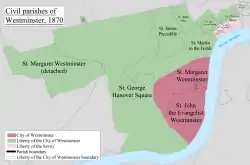St Mary le Strand (parish)
St Mary le Strand was an ancient parish in the metropolitan area of London, England. It was partly within the Liberty of the Savoy and partly within the Liberty of Westminster. It took its name from the church of St Mary and the Innocents. The church was demolished in 1548 during the construction of Somerset House and not rebuilt until 1723. The parish was de facto merged with the Precinct of the Savoy as "St Mary Savoy", but an attempt to merge the parishes de jure in the early 18th century failed. It was restored as a separate parish following the construction of the New Church in the Strand in 1723. The parish was grouped into the Strand Poor Law Union in 1836 and the Strand District in 1855. In 1889 it became part of the County of London and the Metropolitan Borough of Westminster from 1900. It was abolished as a civil parish in 1922.
| St Mary le Strand | |
|---|---|
 | |
| Area | |
| • 1881 | 15 acres (0.061 km2) |
| • 1901/1921 | 14 acres (0.057 km2) |
| Population | |
| • 1881 | 1,989 |
| • 1901 | 494 |
| • 1921 | 85 |
| History | |
| • Abolished | 1922 |
| • Succeeded by | City of Westminster (parish) |
| Status | Civil parish |
| Contained within | |
| • District | Strand (1855–1900) |
| • Poor Law Union | Strand (1836–1913) City of Westminster (1913–1922) |
History
The ancient parish church of St Mary and the Innocents was demolished in 1548 when Somerset House was constructed. Edward Seymour promised to provide a replacement, but it was never built. The parish was not counted separately from 1549 to 1723.[1] Parishioners initially used the church of St Clement Danes[2] and then the Savoy Chapel from 1558.[3] The parish was de facto merged with the Precinct of the Savoy, becoming known as "St Mary Savoy".[4] In 1606 "St Mary Savoy" was added to the returns of the Bills of mortality.
In 1702 the Savoy Hospital was closed and an attempt was made in parliament in 1703 as part of the Savoy Hospital Bill to combine the parishes de jure.[notes 1] This was opposed and never carried out. The parishioners of St Mary le Strand were made to renounce their claim before they were permitted to use the Savoy Chapel again.[3] From 1700 to 1727 "St Mary Savoy in the Strand" appears in the bills of mortality.[5] In 1723 a replacement New Church in the Strand was built by the Commission for Building Fifty New Churches. In the annual bills returns from 1726 there is an entry for St Mary le Strand and the Precinct of the Savoy appears separately from 1728.[5]
Governance
In 1836 it was grouped into the Strand Poor Law Union with two guardians elected for the Westminster part and one guardian elected for the Duchy of Lancaster part.[6] It was grouped into the Strand District in 1855 when it came within the area of responsibility of the Metropolitan Board of Works. In 1889 the parish became part of the County of London and in 1900 it became part of the Metropolitan Borough of Westminster. It was abolished as a civil parish in 1922.
Geography
It had a southern boundary with the River Thames.[7] The part within the Liberty of Westminster was north of the Strand and the part within the Liberty of the Savoy was primarily to the south of the Strand.
Population
The population of St Mary le Strand at the decennial census was:[8]
| Year | 1801 | 1811 | 1821 | 1831 | 1841 | 1851 | 1871 | 1881 | 1891 | 1901 | 1911 | 1921 |
|---|---|---|---|---|---|---|---|---|---|---|---|---|
| Population | 1,704 | 1,578 | 1,784 | 2,052 | 2,520 | 2,517 | 2,007 | 1,989 | 1,549 | 494 | 74 | 85 |
Notes
- "Petition of Charles, E. Dorset and Middlesex, and of certain of his tenants, on behalf of themselves and the rest of the Earl's tenants in the parish of St. Mary-le-Strand, co. Middlesex. In the Bill for enabling her Majesty to settle the lands and revenues of the late dissolved hospital of the Savoy to such charitable and public uses as are therein mentioned, there are several clauses relating to the uniting the said parish to the precinct of the Savoy, by which Petitioners will be much prejudiced. Pray to be heard against these clauses."
References
- Youngs, Frederic (1979). Guide to the Local Administrative Units of England. I: Southern England. London: Royal Historical Society. ISBN 0-901050-67-9.
- London parishes, (1824)
- The Church chronicle, a monthly record of Church life and Church work, (1869)
- London in the nineteenth century, (1829), Jones & Co.
- Collection of Yearly Bills of Mortality, from 1657 to 1758 Inclusive, A. Miller, (1759)
- Parliamentary Papers, House of Commons and Command, Volume 29, Part 1, H.M. Stationery Office, (1836)
- Port, M. H. (Edr.) (1986). "Illustrative map of London parishes". The Commissions for building fifty new churches: The minute books, 1711-27, a calendar. London Record Society.
- http://www.visionofbritain.org.uk/unit/10052634/cube/TOT_POP

